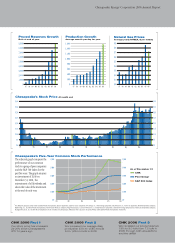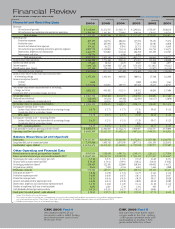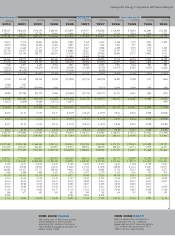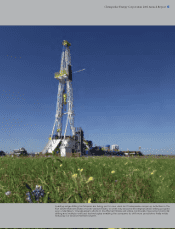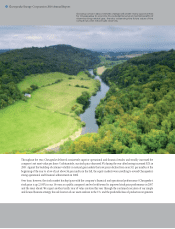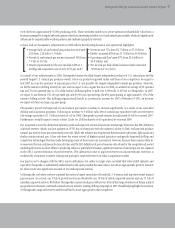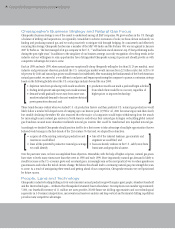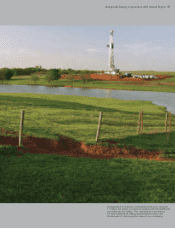Chesapeake Energy 2006 Annual Report Download - page 12
Download and view the complete annual report
Please find page 12 of the 2006 Chesapeake Energy annual report below. You can navigate through the pages in the report by either clicking on the pages listed below, or by using the keyword search tool below to find specific information within the annual report.
10
Chesapeake Energy Corporation 2006 Annual Report
People
First and foremost, Chesapeake is a people company – our employees work creatively and enthusiastically for our shareholders
to profitably produce an environmentally superior product millions of Americans rely on every day. In 2000, Chesapeake was one
of the first companies to recognize that after 15 years of downsizing, the E&P industry was not prepared to meet the rising demand
for natural gas. The average age of a petroleum geoscientist, landman or engineer in the U.S. is now more than 50 years and after
a five-year increase in energy prices, the country is still graduating fewer than 3,500 petroleum geoscientists and engineers per
year (compared to almost 44,000 new lawyers each year). Retirements are estimated to be running at almost the same level as
new graduates are entering the industry, and these retirements will accelerate in the next 15 years as today’s average-aged
geoscientist, landman and engineer reaches traditional retirement age.
Because of Chesapeake’s early recognition of this looming shortage of industry talent, we began aggressively hiring young technical
talent. We now employ more than 200 degreed geoscientists, landmen and engineers under the age of 35, and the average age
of our geoscience, land and engineering departments has dropped from 49 in 2000 to 40 today. Talent creates value and our
company has an abundance of talented people creating value every day. Chesapeake now employs nearly 1,100 employees in its
geoscience, land and engineering departments, of which 70% are degreed professionals.
In total, the company has approximately 5,000 employees, of whom approximately 60% work in our E&P operations and 40%
work in our oilfield service operations. Chesapeake’s people are a highly valued (and much coveted) resource and we are proud
they have chosen our company as their professional home. Continuing a tradition we started in 1994, a complete list of our
employees sorted by the year they joined the company begins on page 28 of this report.
Land
Now I would like to turn to my favorite of the three building blocks of value creation – land (in full disclosure of my bias on this
point, I am a history major by education but a petroleum landman by vocational training). Land is the foundation of all value
creation in the E&P business. Geoscientists and engineers can have great ideas, but without a lease those great ideas have no value
– as we say in the business, “Without the lease, there is no grease.” Chesapeake is one of the few E&P companies
to have a landman as its CEO, and perhaps as a consequence, we have been more willing than our competitors
to acquire an unusually large inventory of leasehold on which to drill wells. Our inventory of 11 million net
acres of leasehold and 26,000 net drilling locations represents more than a 10-year drilling backlog and a
vast storehouse of unrecognized value in our company.
We embarked on this aggressive “land grab” in 2000 as we recognized earlier than most of our competitors
that vast new areas of the U.S. would open up for natural gas exploration and development when new horizontal
drilling and completion technologies were applied to different types of rocks (now commonly referred to as
“unconventional reservoirs”) in a time of structurally higher natural gas prices. We believed this decade
would go down in oil and natural gas history as a once-in-a-generation opportunity to acquire leases in the
modern day equivalent of the great Oklahoma land rushes of the late 19th century.
Today that land grab is largely over, and not surprisingly, we believe Chesapeake won. The leasehold we now
own could not be reassembled in today’s ultra-competitive marketplace – and what we have built is unique,
large and exceptionally valuable. Our investment to date in this undeveloped leasehold exceeds $6 billion, but we believe its value
over time will prove to be a significant multiple of that. Having acquired this enormous inventory of opportunities, we have also
been building the employee, infrastructure and support systems to enable Chesapeake to execute a drilling program with a size
and technological sophistication that is unprecedented in the E&P industry. The results of this drilling program over the next few
years are likely to make Chesapeake the largest producer of natural gas in the U.S. and should create billions of dollars of value
for our shareholders.
0605040302
Net Leasehold
Acres in millions
12
10
8
6
4
2
0



